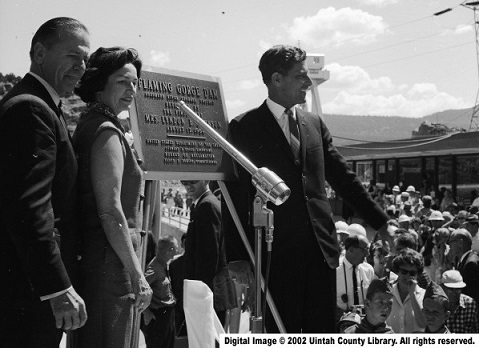Dublin Core
Title
Description
Controversy over public lands has a long history in Utah. The construction of Flaming Gorge Dam was met with resistance, and opinions over the finished product were mixed.
In 1968, the Flaming Gorge Dam in Daggett County was dedicated by Ladybird Johnson, wife of then-President Lyndon Johnson. Initially, plans to build a dam on Utah’s stretch of the upper Green River seemed to center on Echo Park inside Dinosaur National Monument, rather than the present-day site of Flaming Gorge, but opposition from conservation groups including the Sierra Club stalled the approval process for the Echo Park Dam and began to turn public support away from the plan. When President Dwight Eisenhower signed into law the bill allowing the development of water reclamation projects on the Green and Upper Colorado River basins, the vision of a dam at Echo Park had melted away and was replaced by the very real plan to build the Flaming Gorge Dam.
Construction on the dam began in 1958, but the first concrete wasn’t poured until 2 years later. To house the workers that built the dam, the federal government and the company that won the construction contract brought trailers and temporary houses to the dam sire, creating an entire town, known as Dutch John, almost overnight. The population of the town, at the height of construction on the dam, numbered over 3,000 people.
By the time construction on the dam wrapped up in 1964, it wore a price tag of 65 million dollars. Not surprisingly, opinions about the dam and the reservoir it created are mixed. Some Daggett County residents claimed the project unleashed a much need economic overhaul of the region, while others miss the tight community they believe vanished with the changes brought by the dam.
Creator
Source
Image: Senator Moss and Mrs. L.B. Johnson at Gorge Dedication. August 27, 1964. Mrs. L.B. Johnson, Senator Frank E. Moss of Utah (left) and Senator Gale W. McGee of Wyoming on (right) unveil the plaque at the dedication ceremony for the Flaming Gorge Dam. Courtesy of Uintah County Library.
_______________
See Michael W. Johnson, with Robert E. Parson and Daniel A. Stebbins, A History of Daggett County (Salt Lake City: Utah State Historical Society and Daggett County Commission, 1998), 189-219; Doris Karren Burton, A History of Uintah County (Salt Lake City: Utah State Historical Society and Uintah County Commission, 1996), 320; and Jay R. Bingham, “Reclamation and the Colorado,” Utah Historical Quarterly 28 (July 1960): 233-249.

